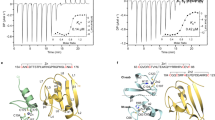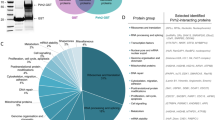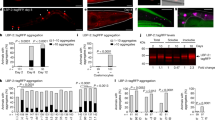Abstract
Cullin-RING ubiquitin ligases promote the polyubiquitination and degradation of many important cellular proteins, which previous studies indicated can be targeted for degradation via interaction with BTB domain-containing subunits of this E3 ligase complex. PEST domains are known to promote the degradation of proteins that contain them. However, the molecular mechanism by which PEST sequences promote degradation of these proteins is not understood. Here we show that the PEST sequences of a short-lived protein called HSF2 interact with Cullin3, a subunit of a Cullin-RING E3 ubiquitin ligase, and that this interaction mediates the Cul3-dependent ubiquitination and degradation of HSF2. These results indicate how, at the molecular level, PEST sequences can promote the proteolysis of proteins that contain them. They also expand understanding of the mechanisms by which substrates can be recruited to Cullin-RING E3 ubiquitin ligases to include interactions between PEST sequences and Cul3.




Similar content being viewed by others
References
Akerfelt M, Trouillet D, Mezger V, Sistonen L (2007) Heat shock factors at a crossroad between stress and development. Ann N Y Acad Sci 1113:15–27
Bosu DR, Kipreos ET (2008) Cullin-RING ubiquitin ligases: global regulation and activation cycles. Cell Div 3:7–19
Brown IR, Gozes I (1998) Stress genes in the nervous system during development and aging diseases. Ann N Y Acad Sci 851:123–128
Furukawa M, He YJ, Borchers C, Xiong Y (2003) Targeting of protein ubiquitination by BTB-Cullin 3-Roc1 ubiquitin ligases. Nat Cell Biol 5:1001–1007
Hollenberg SM, Sternglanz R, Cheng PF, Weintraub H (1995) Identification of a new family of tissue-specific basic helix-loop-helix proteins with a two-hybrid system. Mol Cell Biol 15:3813–3822
Hotton SK, Callis J (2008) Regulation of cullin RING ligases. Annu Rev Plant Biol 59:467–489
Mathew A, Mathur SK, Morimoto RI (1998) Heat shock response and protein degradation: regulation of HSF2 by the ubiquitin-proteasome pathway. Mol Cell Biol 18:5091–5098
Mathew A, Mathur SK, Jolly C, Fox SG, Kim S, Morimoto RI (2001) Stress-specific activation and repression of heat shock factors 1 and 2. Mol Cell Biol 21:7163–7171
McEvoy JD, Kossatz U, Malek N, Singer JD (2007) Constitutive turnover of cyclin E by Cul3 maintains quiescence. Mol Cell Biol 27:3651–3666
Morange M, Favet N, Loones MT, Manuel M, Mezger V, Michel E, Rallu M, Sage J (1998) Heat-shock genes and development. Ann N Y Acad Sci 851:117–122
Petroski MD, Deshaies RJ (2005) Function and regulation of cullin-RING ubiquitin ligases. Nat Rev Mol Cell Biol 6:9–20
Pintard L, Willems A, Peter M (2004) Cullin-based ubiquitin ligases: Cul3-BTB complexes join the family. EMBO J 23:1681–1687
Pirkkala L, Alastalo TP, Nykanen P, Seppa L, Sistonen L (1999) Differentiation lineage-specific expression of human heat shock transcription factor 2. FASEB J 13:1089–1098
Pirkkala L, Nykanen P, Sistonen L (2001) Roles of the heat shock transcription factors in regulation of the heat shock response and beyond. FASEB J 15:1118–1131
Rabindran SK, Giorgi G, Clos J, Wu C (1991) Molecular cloning and expression of a human heat shock factor, HSF1. Proc Natl Acad Sci U S A 88:6906–6910
Rechsteiner M (1991) Natural substrates of the ubiquitin proteolytic pathway. Cell 66:615–618
Rechsteiner M, Rogers SW (1996) PEST sequences and regulation by proteolysis. Trends Biochem Sci 21:267–271
Rogers S, Wells R, Rechsteiner M (1986) Amino acid sequences common to rapidly degraded proteins: the PEST hypothesis. Science 234:364–368
Sarge KD, Park-Sarge OK (2005) Gene bookmarking: keeping the pages open. Trends Biochem Sci 30:605–610
Sarge KD, Zimarino V, Holm K, Wu C, Morimoto RI (1991) Cloning and characterization of two mouse heat shock factors with distinct inducible and constitutive DNA-binding ability. Genes Dev 5:1902–1911
Schuetz TJ, Gallo GJ, Sheldon L, Tempst P, Kingston RE (1991) Isolation of a cDNA for HSF2: evidence for two heat shock factor genes in humans. Proc Natl Acad Sci U S A 88:6911–6915
Sumara I, Maerki S, Peter M (2008) E3 ubiquitin ligases and mitosis: embracing the complexity. Trends Cell Biol 18:84–94
Willems AR, Schwab M, Tyers M (2004) A hitchhiker’s guide to the cullin ubiquitin ligases: SCF and its kin. Biochim Biophys Acta 1695:133–170
Xing H, Wilkerson DC, Mayhew CN, Lubert EJ, Skaggs HS, Goodson ML, Hong Y, Park-Sarge OK, Sarge KD (2005) Mechanism of hsp70i gene bookmarking. Science 307:421–423
Acknowledgments
We are grateful to Dr. Jeffrey Singer for his gift of the Cul3+/+ and Cul3+/− MEF cells, to Dr. Yue Xiong for providing anti-Cul3 antibodies, and to other members of the laboratory for comments. This research was supported by NIH grant GM64606 to K.D.S.
Author information
Authors and Affiliations
Corresponding author
Rights and permissions
About this article
Cite this article
Xing, H., Hong, Y. & Sarge, K.D. PEST sequences mediate heat shock factor 2 turnover by interacting with the Cul3 subunit of the Cul3-RING ubiquitin ligase. Cell Stress and Chaperones 15, 301–308 (2010). https://doi.org/10.1007/s12192-009-0144-7
Received:
Accepted:
Published:
Issue Date:
DOI: https://doi.org/10.1007/s12192-009-0144-7




